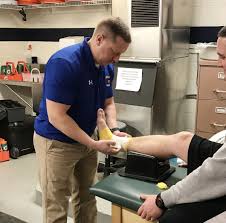
Article reposted from The Progress
Author:
When Glendale athletic trainer Jeff Smithbower realized he wouldn’t be playing baseball professionally, he decided he needed to find a different profession to pursue.
After deciding against working in other fields directly associated with baseball, he turned to athletic training, which allowed him to to stay involved with sports.
“I loved playing baseball and working out in my younger years and figured that if I couldn’t play baseball professionally that I would find a career to still be around it,” Smithbower said. “I lived in the weight room in my high school days and was always interested in the science behind training and improving athletic performance.
“Originally, I wanted to take the path to work in professional sports but I realized baseball is a pretty boring sport when you’re not actually in the game yourself and the hours, pay, and lifestyle were different than I imagined.”
The Penn Cambria grad went to Penn State University and majored in kinesiology with the athletic training option and then went to Mount Aloysius College to get his degree as a physical therapist assistant.
Since starting out Smithbower has worked for ProCare Health Systems and covered Cambria Heights and Mount Aloysius College. He has also filled in at Penn State Altoona.
He came to Glendale in 2008 and has been there ever since.
Since he is employed by the school and not contracted out, Smithbower’s day usually begins right when the students of Glendale are switching gears into athletic mode — the final period bell.
“Typically I come in after school lets out, check my email, and work with any athletes that are currently injured or need treatment and it can vary from 0-10 people depending on the time of year,” he said. “Sometimes athletes pop in and have a question or concern and I will take a look at them. My room is next to the weight room so I usually stop in there to see if there’s anything going on. Then I usually make rounds to each practice just to see what they are doing for the day and if anyone else needs me.
“If there’s a game that night then I will start to get equipment ready for the game and set up in the gym or out at one of the fields. If there’s a game that night then I always try to be present for it while keeping radio contact available with the other teams practicing in case they need me.”
Smithbower said the best part of his job is being around his athletes and getting to watch them play sports.
“I get paid to be around sports,” he said. “It beats doing physical labor and a lot of other jobs out there. I’ve built some great relationships with people over the years whether they were athletes or coaches. The athletic world is definitely a place where you get out what you put into it and I love it when the hard work pays off for the people I’m around.”
With over eight years of memories, Smithbower said it isn’t a specific sports moment that sticks out as his favorite, rather a group of athletes that he was able to follow.
“It’s hard to pick one (a favorite), but I really enjoyed the time I had working with the group of kids that graduated around 2011,” he said. “They were really good kids that worked hard, were coachable, and had great attitudes. It didn’t feel like work when they were around and I was always excited to watch them play.”
Smithbower says while he loves his job, there are a lot of misconceptions about what the profession actually entails, with some comparing it to completely different fields.
“The title “athletic trainer” gives people the impression that we are the same thing as “personal trainers” and its a constant battle to educate people that we are healthcare providers,” he said. “I was guilty myself when I chose the path in college of thinking that it was mostly “training” related when in fact it is more oriented around injuries as we are healthcare providers. It is a relatively new profession and I think in time the connotation will change as people are exposed to the professional.”
While the job allows Smithbower to be around sports on a daily basis, there are some downsides to the life of an athletic trainer.
“The second shift type hours definitely makes it less enjoyable at times, but I don’t mind it too much because I honestly don’t know what else I would be doing with my evenings anyway,” said Smithbower. “Losing definitely takes it toll on all the people associated with it and lately we have been struggling to be as competitive as we would like in different areas.”
In all of his different experiences, it’s two baseball injuries that stick out the most.
“I was working a college baseball game where two players collided head to head in the field and left them both unconscious,” he said. “In second place would be another baseball injury when I was an undergrad student where a player was struck in the face by a 85 mph foul ball. To this day it makes me cringe and I’m always warning people to be aware around the backstop.”
Smithbower also likes to give another bit of advice for anyone thinking of getting into the field.
“Job shadow multiple places so that you can have an idea of what its really like in different settings,” he said.